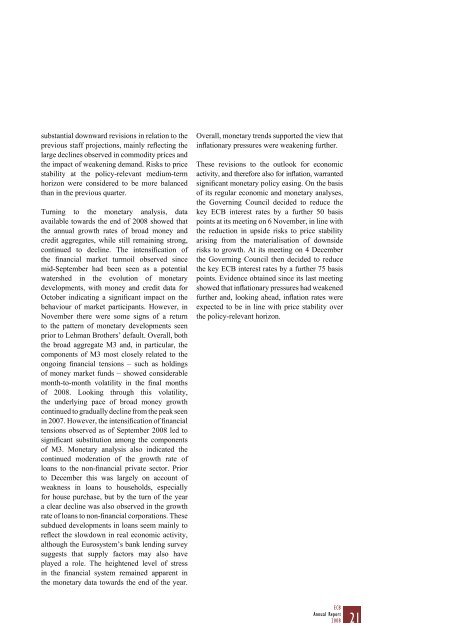ANNUAL REPORT 2008 - Polymer Bank Notes of the World
ANNUAL REPORT 2008 - Polymer Bank Notes of the World
ANNUAL REPORT 2008 - Polymer Bank Notes of the World
You also want an ePaper? Increase the reach of your titles
YUMPU automatically turns print PDFs into web optimized ePapers that Google loves.
substantial downward revisions in relation to <strong>the</strong>previous staff projections, mainly reflecting <strong>the</strong>large declines observed in commodity prices and<strong>the</strong> impact <strong>of</strong> weakening demand. Risks to pricestability at <strong>the</strong> policy-relevant medium-termhorizon were considered to be more balancedthan in <strong>the</strong> previous quarter.Turning to <strong>the</strong> monetary analysis, dataavailable towards <strong>the</strong> end <strong>of</strong> <strong>2008</strong> showed that<strong>the</strong> annual growth rates <strong>of</strong> broad money andcredit aggregates, while still remaining strong,continued to decline. The intensification <strong>of</strong><strong>the</strong> financial market turmoil observed sincemid-September had been seen as a potentialwatershed in <strong>the</strong> evolution <strong>of</strong> monetarydevelopments, with money and credit data forOctober indicating a significant impact on <strong>the</strong>behaviour <strong>of</strong> market participants. However, inNovember <strong>the</strong>re were some signs <strong>of</strong> a returnto <strong>the</strong> pattern <strong>of</strong> monetary developments seenprior to Lehman Bro<strong>the</strong>rs’ default. Overall, both<strong>the</strong> broad aggregate M3 and, in particular, <strong>the</strong>components <strong>of</strong> M3 most closely related to <strong>the</strong>ongoing financial tensions – such as holdings<strong>of</strong> money market funds – showed considerablemonth-to-month volatility in <strong>the</strong> final months<strong>of</strong> <strong>2008</strong>. Looking through this volatility,<strong>the</strong> underlying pace <strong>of</strong> broad money growthcontinued to gradually decline from <strong>the</strong> peak seenin 2007. However, <strong>the</strong> intensification <strong>of</strong> financialtensions observed as <strong>of</strong> September <strong>2008</strong> led tosignificant substitution among <strong>the</strong> components<strong>of</strong> M3. Monetary analysis also indicated <strong>the</strong>continued moderation <strong>of</strong> <strong>the</strong> growth rate <strong>of</strong>loans to <strong>the</strong> non-financial private sector. Priorto December this was largely on account <strong>of</strong>weakness in loans to households, especiallyfor house purchase, but by <strong>the</strong> turn <strong>of</strong> <strong>the</strong> yeara clear decline was also observed in <strong>the</strong> growthrate <strong>of</strong> loans to non-financial corporations. Thesesubdued developments in loans seem mainly toreflect <strong>the</strong> slowdown in real economic activity,although <strong>the</strong> Eurosystem’s bank lending surveysuggests that supply factors may also haveplayed a role. The heightened level <strong>of</strong> stressin <strong>the</strong> financial system remained apparent in<strong>the</strong> monetary data towards <strong>the</strong> end <strong>of</strong> <strong>the</strong> year.Overall, monetary trends supported <strong>the</strong> view thatinflationary pressures were weakening fur<strong>the</strong>r.These revisions to <strong>the</strong> outlook for economicactivity, and <strong>the</strong>refore also for inflation, warrantedsignificant monetary policy easing. On <strong>the</strong> basis<strong>of</strong> its regular economic and monetary analyses,<strong>the</strong> Governing Council decided to reduce <strong>the</strong>key ECB interest rates by a fur<strong>the</strong>r 50 basispoints at its meeting on 6 November, in line with<strong>the</strong> reduction in upside risks to price stabilityarising from <strong>the</strong> materialisation <strong>of</strong> downsiderisks to growth. At its meeting on 4 December<strong>the</strong> Governing Council <strong>the</strong>n decided to reduce<strong>the</strong> key ECB interest rates by a fur<strong>the</strong>r 75 basispoints. Evidence obtained since its last meetingshowed that inflationary pressures had weakenedfur<strong>the</strong>r and, looking ahead, inflation rates wereexpected to be in line with price stability over<strong>the</strong> policy-relevant horizon.ECBAnnual Report<strong>2008</strong>21




![KNOW YOUR NEW GIBRALTAR BANKNOTES - [Home] bThe/b](https://img.yumpu.com/50890985/1/184x260/know-your-new-gibraltar-banknotes-home-bthe-b.jpg?quality=85)
![PAPUA NEW GUINEA - [Home] - Polymer Bank Notes of the World](https://img.yumpu.com/49758743/1/190x143/papua-new-guinea-home-polymer-bank-notes-of-the-world.jpg?quality=85)










